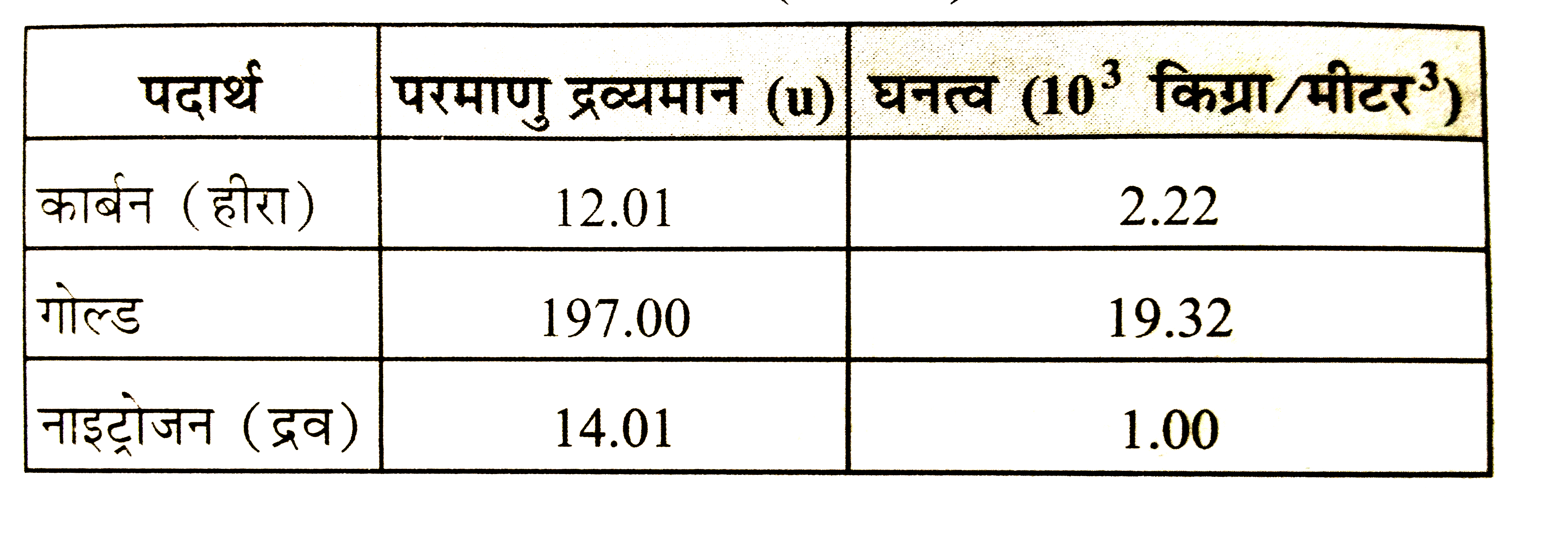Estimate the size of fluorine (liquid) molecule, given its atomic mass 19.01u and density 1.14×103kgm−3. Solution in Kannada
Volume of a single molecule =mass of each moleculedensity
i.e. 43πR3=12.01×1.66×10−272.22×103,1μ=1.66×10−27kg
i.e. R3=3×12.01×1.66×10−302.22×4×3.142=2.144×10−30.
i.e. radius of each molecule R=(2.144)13×10−10m=1.289×10−10m.
1.289Å
Topper's Solved these Questions
- KINETIC THEORYBOOK - SUBHASH PUBLICATIONCHAPTER - KINETIC THEORYEXERCISE - FIVEMARK QUESTION AND ANSWERS
4 Videos
- GRAVITATION BOOK - SUBHASH PUBLICATIONCHAPTER - GRAVITATION EXERCISE - NUMERICALS WITH SOLUTIONS
15 Videos
- LAWS OF MOTIONBOOK - SUBHASH PUBLICATIONCHAPTER - LAWS OF MOTIONEXERCISE - Numericals with solutions
15 Videos
Similar Questions
Obtain an expression for the pressure of an ideal gas from the kinetic theory of an ideal gas.
View SolutionAssuming the distance of the Moon from the Earth R=3.84×108m and Moon's period of revolution as 27.3 days, calculate the mass of the Moon.
View SolutionA force of 100N acts on a body of mass 0.25kg for 2s. Calculate acceleration of the body and its change in momentum.
View SolutionThe density of water is 10^(3) kg//m^(3) . Estimate the size ("in" Å) of a water molecule.
View SolutionA metallic sphere floats in immiscible mixture of water (density 10^(3) kgm^(-3)) and a liquid (density 8xx10^(3) kgm^(-3)) such that its (2//3) part is in water and (1//3) part in the liquid. The density of the metal is
View Solutionनीचे कुछ ठोसों व द्रवों के घनत्व दिये गये हैं । उनके परमाणुओं की आमापों का आंकलन (लगभग) कीजिए।

View SolutionEstimate the size of fluorine (liquid) molecule, given its atomic mass 19.01u and density 1.14kgm−3.
View SolutionEstimate the size of diamond molecule given its atomic mass 12.01u and density 2.22 xx 10^3 "kgm"^(-3) .
View SolutionFind the radius of atom: Edge length = 405pm, density = 2.7xx10^3 kgm^(-3) , atomic mass = 2.7xx10^(-2)kg
View SolutionEstimate the average mass density of a sodium atom assuming its size to be about 2.5Å. (Use the known values of Avagardo's number and the atomic mass of sodium). Compare it with the mass density of sodium in its crystalline phase : 970kgm−3. Are the two densities of the same order of magnitude ? If so, why ?
View SolutionEstimate the average mass density of a sodium atom assuming its size to be about 2.5Å. (Use the known values of Avagardo's number and the atomic mass of sodium). Compare it with the mass density of sodium in its crystalline phase : 970 kg m^(-3) . Are the two densities of the same order of magnitude ? If so, why ?
View SolutionEstimate the volume of a water molecule using the data of one molecule( density of water = 1000kg/m3) What is its approximate size?
View SolutionEstimate the average mass density of a sodium atom assuming its size to be about 2.5Å. (Use the known values of Avagardo's number and the atomic mass of sodium). Compare it with the mass density of sodium in its crystalline phase : 970kgm−3. Are the two densities of the same order of magnitude ? If so, why ?
View SolutionEstimate the average mass density of a sodium atom assuming its size to be about 2.5Å. (Use the known values of Avagardo's number and the atomic mass of sodium). Compare it with the mass density of sodium in its crystalline phase : 970kgm−3. Are the two densities of the same order of magnitude ? If so, why ?
View SolutionFind the radius of atom:
Edge length = 405pm, density = 2.7×103kgm−3, atomic mass = 2.7×10−2kg
View Solution
